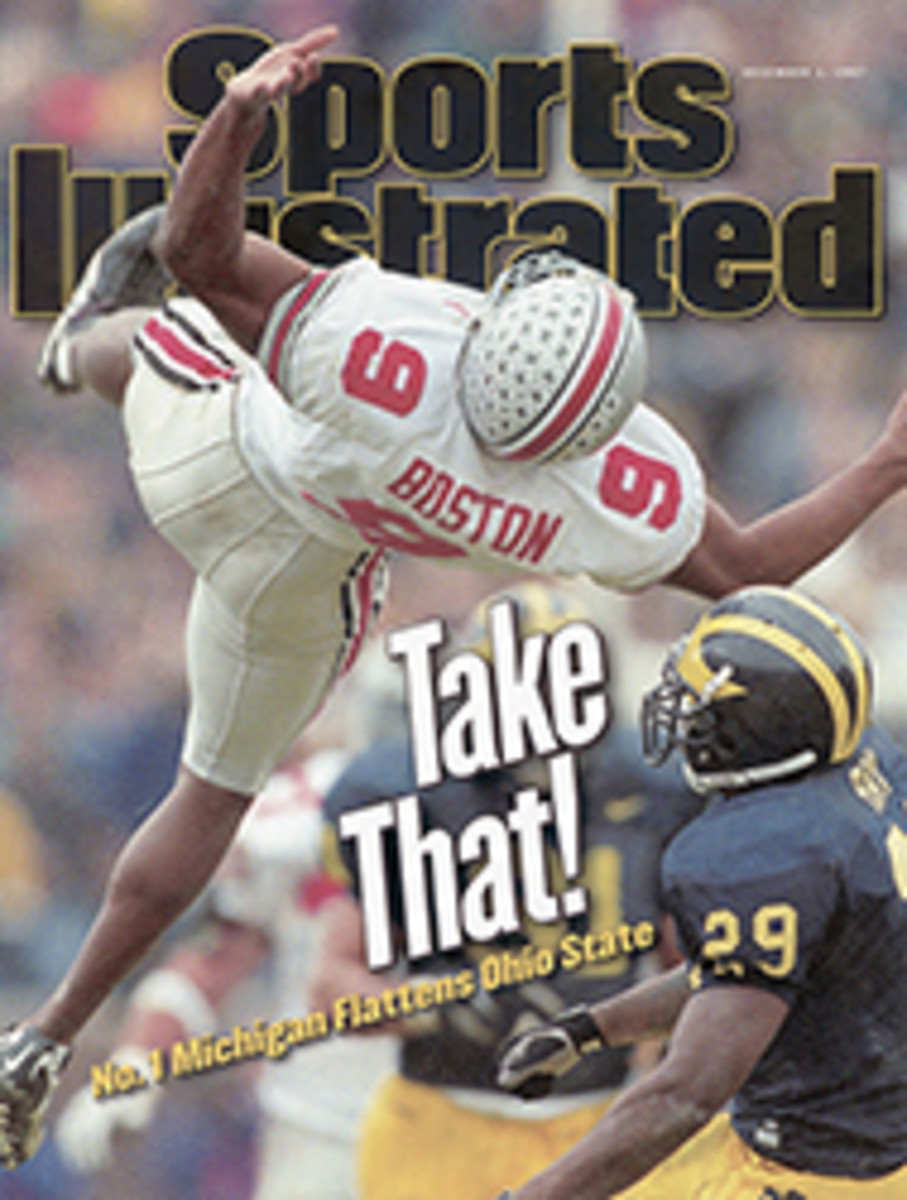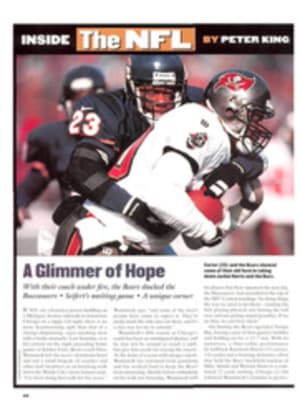
BREEDER GOES THE DISTANCE HANGING AROUND HORSES, SAYS 100-YEAR-OLD FRED HOOPER, IS THE SECRET TO A LONG, FULL LIFE
Fred Hooper hardly seems like a Swamp Rabbit. He's bent and a
bit infirm and moves slowly on a wheeled walker he calls his
"horse." But his mind is quick and light, and at 100, he still
sparks with edgy energy as he talks. Well-wishers have been
throwing him birthday parties here and there in the horse racing
world for months. "Horse manure," says the Swamp Rabbit, his
pale, pale face absolutely aglow. "That's the secret to my
longevity. Manure makes a fella feel young."
He says this while steering a golf cart through a hickory grove
on his 912-acre spread in Ocala, Fla. Throughout the estate,
from breeding sheds to training gallops, all is immaculately
groomed. Flowers abound. Grass is clipped. Stables are clean and
freshly painted, masonry pointed and trim, tack in order, hay
baled, manure invisible. Hooper, who achieved the century mark
on Oct. 6, inspects his cattle, looks in on his broodmares, does
a little business. He likes the action. He doesn't want to sit
around his house waiting for the Day. He's got too much to do.
Hooper has always been an action guy. He has been a boxer, a
schoolteacher, a barber, a carpenter, a riveter, a logger, a
potato farmer, a road construction contractor and always a
maverick. Currently he is the grandest horseman of them all.
"Fred's the most interesting person I've ever met," says Chuck
Tilley, former head of the Florida Thoroughbred Breeders'
Association. "Of course, he's had longer to do things than the
rest of us."
Brash and unabashedly unsophisticated, Hooper has been kicking
mud in the faces of the gentry ever since winning the 1945
Kentucky Derby with the first thoroughbred he owned. The hundred
or so stakes winners he has bred and raised over the last half
century have earned more than $50 million. "My horses are like
my kids," says Hooper, whose child-rearing methods earned him
Eclipse awards as the nation's outstanding breeder in 1975 and
'82. "I bring [up] my horses myself. I don't send 'em out to be
raised by somebody else."
A breeding pioneer, Hooper turned his back on Kentucky hardboots
in the 1950s by leaving the mainstream of American bloodstock.
He went abroad for jockeys as well, importing from Panama the
exceptional Braulio Baeza, Laffit Pincay Jr. and Jorge
Velasquez. Along the way he helped found the Thoroughbred Owners
and Breeders Association in 1961, and oversaw the turf course
construction as a consultant at Arlington, Gulfstream and
Hollywood parks. "I know dirt," Hooper says.
Racing's reigning centenarian values honesty and courage and
intelligence and integrity. If he invites you into his kitchen
for a bowl of orange-juice-soaked cereal, you know you have
passed his stringent, idiosyncratic test of character.
Canniness, however, is the chief virtue of Hooper the
Businessman. Way back in 1949 he accepted a challenge from
Quintas Roberts, owner of champion quarter horse Stella Moore.
Roberts's filly was matched at a quarter mile against Hooper's
swift thoroughbred Olympia in an exhibition at Tropical Park in
Miami. Each man put up $25,000, winner take all. "People thought
I was crazy to let Olympia race a quarter horse at two
furlongs," says Hooper, who covered his original bet with
$93,000 in side bets. "I knew I was crazy, all right, but
Olympia was awful fast, and I thought he could beat anybody." To
the surprise of everyone except Hooper, Olympia lunged out of
the gate first, held on to the wire and won by a diminishing
head in :22 4/5. "I told Roberts that if he was game, I'd fetch
another thoroughbred from my stable," Hooper says. "He said,
'No, thanks. I've got just enough money to get back home.'"
Hooper was a horse trader before he owned his first horse. At 14
the Georgia hayseed bought, broke and sold a truckload of wild
mustangs from Montana, turning a tidy profit. At 15 he cleaned
up at the state fair, pocketing $5 for riding a motorcycle
around the wall of a cycling chamber; $10 for twice decking a
prizefighter; and $15 for not letting a bronc buck him. By the
age of 18 he had graduated from Molar Barber College in Atlanta
and was on the fast track toward the head chair at Crawford's
Barber Shop.
When Hooper heard he could get rich growing potatoes in Florida,
he borrowed enough cash to buy 40 acres in the Sunshine State.
He raked and hoed, hoed and raked--and in three years owned 230
acres. By 1923 his hopes of a spud empire were mashed flat. A
potato blight wiped him out in four days. "I was $20,000 in
debt," he says. "So I went to my banker and said, 'You're
looking at a contractor now.'" Buying heavy equipment on credit,
he launched the Hooper Construction Company and began paving
roads in Flagler County. "I became known as the Swamp Rabbit,"
he says. "I'd build roads where no one else dared go." Soon he
was building highways, dams, canals, bridges and airfields all
over the Southeast.
Hooper got hooked on horses in the late 1930s. He had bought a
cow pony named Prince to work cattle on a ranch he owned in
Alabama. Prince had great speed, and Hooper's father suggested
he try the horse in match races. "Prince won 49 of 55 races,"
Hooper recalls. "After he'd beaten all comers, I renamed him
Royal Prince. I figured he'd earned it."
In 1943 Hooper went to Keeneland's summer yearling sales to
start a breeding operation. He had intended to buy some fillies
by Sir Gallahad III, who had sired two Derby winners--Gallant
Fox in 1930 and Gallahadion in 1940. "But I fell in love with
one of Sir Gallahad's sons," Hooper says. "He had a sharp style
of walking, and every time I saw him, I fell in love a little
more." Hooper became so smitten that he shelled out $10,200 for
the bay colt--about 10 times the going rate--and named him Hoop
Jr., after his son, Freddie.
Hoop Jr. ran five times as a 2-year-old, winning twice, placing
second in the other three and inspiring his owner to declare,
"He'll win the Kentucky Derby next year." With Eddie Arcaro up,
Hoop Jr. did just that. The track was sloppy, and Hooper told
the jockey, "When you come out of that gate--go! The horse, you
and the colors will look a lot better without all that mud on
you." Arcaro complied, turning a one-length lead in the early
stretch to six at the finish. "That's the most expensive race
you'll ever win," Arcaro later told Hooper.
"Why is that?" the owner asked.
"Now you'll spend the rest of your life trying to win it again."
Three other horses have worn Hooper's distinctive red, white and
blue silks during the Run for the Roses. Olympia was the odds-on
favorite in '49 but finished sixth; Crozier was second to Carry
Back in '61; and Admiral's Voyage placed ninth in '62. While
Hooper hasn't had a Derby starter since, he has achieved
consistent success as a breeder. Eschewing yearling auctions,
Hooper matches his own mares with his own stallions. The result
of this unorthodox approach is the so-called Hooper Line, which
includes such standouts as Copelan, Tri Jet and 1985 Breeder's
Cup Sprint winner Precisionist. Hooper's favorite remains
Susan's Girl. An oil painting of the Hall of Fame filly hangs
prominently in the foyer of his Ocala home. "She won more than
$1.2 million," Hooper says. "No other female that raced
exclusively in this country had ever made that much. She won
Eclipse awards in 1972, '73 and '74."
"It was '72, '73 and '75," says his wife, Wanda. "Susan's Girl
fractured a sesamoid and missed the '74 season." Turned out at
the farm in Ocala, the bay mare swam herself back to health and
made one of racing's greatest comebacks. "Some Japanese guys
offered me $4 million for her," says Hooper, referring to
Susan's Girl, not Wanda. "Made three different offers."
Wanda: "And each time Fred refused."
Fred: "I told them, 'As long as I have two weeks groceries in
the house, I won't sell her."
Wanda and Fred met on an airplane. She was a flight attendant;
he, the only passenger in first class. "Perhaps you'd like to
sit in coach," she suggested. "First class won't be having meal
service."
Hooper roared as if he had been harpooned: "Hell, no! I'm first
class, and I'm gonna sit here! Bring me an Old Forester and
Seven-Up."
They were married in 1970; Wanda became Fred's Wife No. 3. Today
they split time between Ocala and Bal Harbour, near Miami.
Though they rarely venture out of Florida anymore, they keenly
follow their promising 2-year-old, Recommended List. The day
before Fred's 100th birthday, the colt won the Garden City
Stakes on grass at New York's Belmont Park.
"For a turf horse," says Fred, "he's got a heck of a chance to
make next year's Kentucky Derby."
"Very doubtful," says Wanda. "He's a long shot. Wishful thinking."
"You're right," says the Swamp Rabbit with a sigh. "But it would
be nice to win 500,000 bucks."
COLOR PHOTO: BILL FRAKES Hooper, at Calder Race Course, is still looking for a second Derby winner 52 years after his first. [Fred Hooper]
B/W PHOTO: AP Arcaro (aboard Hoop Jr.) heeded the owner's order to keep his silks clean, and won the 1945 Derby. [Fred Hooper holding reins of horse Hoop Jr. on which Eddie Arcaro sits]

